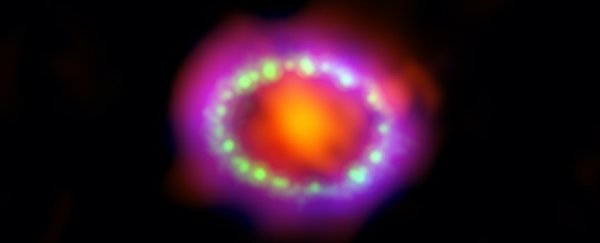Life was trying, but it wasn't working out. As the Late Devonian period dragged on, more and more living things died out, culminating in one of the greatest mass extinction events our planet has ever witnessed, approximately 359 million years ago.
The culprit responsible for so much death may not have been local, scientists say. In fact, it might not have even come from our Solar System.
Rather, a study published in August last year, led by astrophysicist Brian Fields from the University of Illinois Urbana-Champaign, suggests this great extinguisher of life on Earth could have been a distant and completely foreign phenomenon – a dying star, exploding far across the galaxy, many light-years away from our own remote planet.
Sometimes, mass die-offs like the Late Devonian extinction are thought to be triggered by exclusively terrestrial causes: a devastating volcanic eruption, for instance, which chokes the planet into lifelessness.
Or, it could be a deadly visitor barging in from out of town – an asteroid collision, like the kind that took out the dinosaurs. Death from space, however, could ultimately come from far more remote places.
"The overarching message of our study is that life on Earth does not exist in isolation," Fields said back in 2020.
"We are citizens of a larger cosmos, and the cosmos intervenes in our lives – often imperceptibly, but sometimes ferociously."
In their new work, Fields and his team explore the possibility that the dramatic decline in ozone levels coinciding with the Late Devonian extinction might not have been a result of volcanism or an episode of global warming.
Instead, they suggest it's possible the biodiversity crisis exposed in the geological record could have been caused by astrophysical sources, speculating that the radiation effects from a supernova (or multiple) approximately 65 light-years from Earth may have been what depleted our planet's ozone to such disastrous effect.
It may be the first time such an explanation has been put forward for the Late Devonian extinction, but scientists have long considered the potentially deadly repercussions of near-Earth supernovas in this kind of context.
Speculation that supernovas could trigger mass extinctions dates back to the 1950s. In more recent times, researchers have debated the estimated 'kill distance' of these explosive events (with estimates ranging between 25 to 50 light-years).
In their recent estimates, though, Fields and his co-authors propose that exploding stars from even farther away could have harmful effects on life on Earth, through a possible combination of both instantaneous and long-lived effects.
"Supernovae (SNe) are prompt sources of ionizing photons: extreme UV, X-rays, and gamma rays," the researchers explain in their paper.
"Over longer timescales, the blast collides with surrounding gas, forming a shock that drives particle acceleration. In this way, SNe produce cosmic rays, that is, atomic nuclei accelerated to high energies. These charged particles are magnetically confined inside the SN remnant, and are expected to bathe Earth for ~100 ky [approximately 100,000 years]."
These cosmic rays, the researchers argue, could be strong enough to deplete the ozone layer and cause long-lasting radiation damage to life-forms inside Earth's biosphere – which roughly parallels evidence of both loss of diversity and deformations in ancient plant spores found in the deep rock of the Devonian–Carboniferous boundary, laid approximately 359 million years ago.
Of course, it's just a hypothesis for now. At present, we don't have any evidence that can confirm a distant supernova (or supernovae) was the cause of the Late Devonian extinction. But we might be able to find something almost as good as proof.
In recent years, scientists examining the prospect of near-Earth supernovas as a basis for mass extinctions have been looking for traces of ancient radioactive isotopes that could only have been deposited on Earth via exploding stars.
One isotope in particular, iron-60, has been the focus of much research and has been found in numerous locations on Earth.
In the context of the Late Devonian extinction, though, other isotopes would be strongly indicative of the extinction-by-supernova hypothesis put forward by Fields and his team: plutonium-244 and samarium-146.
"Neither of these isotopes occurs naturally on Earth today, and the only way they can get here is via cosmic explosions," explained co-author and astronomy student Zhenghai Liu from the University of Illinois Urbana-Champaign.
In other words, if plutonium-244 and samarium-146 and can be found buried in the Devonian–Carboniferous boundary, the researchers say we'll basically have our smoking gun: interstellar evidence that firmly implicates a dying star as the trigger behind one of Earth's worst-ever die-offs.
And we'll never look up at the skies in quite the same way again.
The findings were reported in PNAS.
A version of this article was first published in August 2020.
